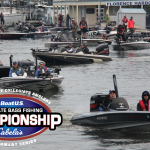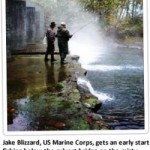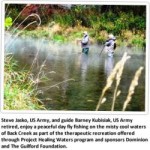
Blast off at a college bass fishing tounament
Today’s Collegiate BASS Fishing Angler, Tomorrow’s Leader
By Danny Blandford
from The Fishing Wire
As an angler that has been involved in college bass fishing since before there was truly organized college bass fishing, I find myself in awe of how far the sport and the participants have come. Likewise, I often find myself in awe at the public perception of college bass fishing among folks that don’t truly understand competitive bass fishing, let alone the value of it at the collegiate level. Only by being close to it since I was eighteen years old (closing in on half my life) have I really come to understand the role it is playing in shaping the future of our great sport.
Over the past year we’ve highlighted what it has meant to current and future professional anglers. Guys like Brandon Card, Justin Rackley, Miles Burghoff, and several other young aspiring professional anglers have recognized and capitalized on the opportunities to develop their competitive skills while fishing at the collegiate level. Fortunately for our sport, competing at the collegiate level is also producing an influx of a different kind of talent to the “other” side of competitive fishing, the industry itself. Many anglers are figuring out how to meld their talents and education, both on and off the water, into successful careers in the fishing industry.
We caught up with a couple of entrepreneurs who fully credit college bass fishing for where they are today and their path towards tomorrow. Brooks Woodward, the founding member of the Florida State Bass Fishing Club is a great example. Brooks rolled into Tallahassee, Florida in January of 2010. He had a passion for bass fishing and a desire to grow that passion into something more. Brooks channeled his energy into creation of the Florida State University Bass Fishing Club, a collection of anglers from across the country that shared his love of bass fishing, along with his competitive drive. Over the past three and a half years, the club has grown to approximately 25 members, competes in national events all across the country, and continues to grow in both membership and experience.
During that time, Brooks’ ideas and passion grew as well. According to Brooks, “It didn’t take me long to see that there was a huge community of like-minded anglers out there; which really opened my eyes to the potential in the fishing business and the size of the market. Once I started thinking about it, I knew it (the fishing industry) was for me and I felt like I had a few options. I looked at trying to land a job with an established company, I looked at starting a company from scratch, and I looked at what existing companies may be out there available to purchase. When it was all said and done, a purchase opportunity presented itself with Nichols Lures and I jumped on it.”
In regards to Nichols, Brooks went on to add, “The company was an established brand that had been producing good products since 1989 so I felt like it was a great place to start. At the time, my opinion was that things were just a bit stagnant and a lot of what was needed was creative work and fresh perspective, both of which I felt I could add. I’m a Graphic Design Major, so things like an updated website, updated packaging, and marketing collateral where all right up my alley.”
He started his journey as a fulltime student and part-time “tackle tinkerer”, and has transitioned into a part-time student and fulltime tackle company owner. When asked about the influence of college fishing and founding a club, Brooks went on to add, “I think college fishing is in large part the reason that I’ve chosen the path that I have. The relationships and camaraderie that I developed through the club made me want to stay in the industry and the contacts I’ve made along the way are helping me to succeed. As I look to grow the ranks here at Nichols, I’ll definitely be looking to likeminded collegiate or former collegiate anglers. I feel like college fishing teaches a unique set of skills and develops traits that I want to see in my own employees. I believe the more a person has been exposed to competitive fishing at this level, the more they can bring to future employers.”
After talking with Brooks I was left with the impression he was a traditional student that took a non-traditional route to pursue his passion, which I found to be a path I completely understood. With that said, it was the common thread of college, competition, and an entrepreneurial spirit that connected us and so many others.
For more content and a different perspective, I reached out to Berkley Product Manager, Stephen Britt. Stephen is what academia defines as a “non-traditional” student, and within minutes of being on the phone, it was clear “non-traditional” was a great adjective to describe Stephen and his passion for bass fishing. Academia uses the term because after high school Stephen spent four years in the United States Marine Corps; followed by two years at the University of South Carolina Salkehatchie, before enrolling in the Moore School of Business at the University of South Carolina’s main campus in Columbia, South Carolina.
Stephen’s story at South Carolina began with aspirations for a business degree with emphasis on management, insurance, and real estate. The “trifecta” for a young entrepreneurial businessman, but definitely “non-traditional” for a guy who had been thinking about life as a professional angler. Aspiration became inspiration when Britt learned that USC didn’t have a fishing team like the ones he had been hearing about at other schools. On January 26, 2009 Stephen hosted a callout meeting for a new bass club on campus and generated a total of five attendees, including him. Although small in size, that little meeting turned out to be a big step in the formation of the Anglers @ USC. The full story of their journey is an interesting one, and you can read it on their website here.
That meeting was important for the club, but it was also important for Stephen himself. It planted a seed that perhaps there are more ways to succeed in fishing other than casting for cash. The seed grew into something more when Stephen received a call from a friend. Apparently there was a guy from Pure Fishing standing in the lobby of the business school looking for people interested in angling and a potential internship. That call was all that it took for Stephen to head to the “B School” to see what was going on. That chance meeting led to an unpaid internship at Pure Fishing; the first internship at the new Columbia, South Carolina Pure Fishing headquarters to be exact. Although it was unpaid, Stephen found it very rewarding.
According to Stephen, “That internship really changed my path. I knew right away I wanted to work in the fishing industry and when it was over I changed up my courses to make me a better candidate for such work. I dropped my insurance courses, added marketing, and began looking for more ways to develop talents that could come in handy in the fishing industry. My time leading the Anglers @ USC was certainly a big part of everything.”
He went on to add, “As I wrapped up my courses and time at USC I started really pursuing Pure Fishing. I went to three different job fairs to keep getting in front of the Pure Fishing recruiter and doing my part to convince him I was the guy for the job. Ultimately, my persistence paid off. I landed the job as a Product Manager for Berkley and I oversee the fishing rods and rod and reel combo segments of our offerings, as well as some of our ice fishing products. I’ve been fortunate to spend the last two years working on something I really enjoy.”
“In summary, I’m excited to have landed where I belong. The subject of my work, the pace at which we do it here at Pure Fishing and my chance to remain involved in competitive fishing is absolutely awesome. I’ve got a career ahead of me…not just a job.”
Stephen and Brooks both spent a lot of time in the interview crediting their college bass club experience and being in the right place at the right time for where they are today. No doubt good timing was a pivotal part of their journey, but I’m convinced it was more than that which led to their early success. These young men “pushed” everything into place rather than waiting for everything to “fall” into place; which is a testament to who they are. With that said, it seems college bass fishing helped motivate them and provide a source of strength to keep moving ahead.
As someone that went through a long journey in academia, as well as the fishing industry, I can say with a fair degree of certainty that very few courses do what college bass fishing can do for a young impressionable man or woman. When coupled together, a passion for fishing and a sound education make a great recipe for success both on and off the water.
I think I can speak on behalf of everyone at the Association of Collegiate Anglers when I say we’re proud to be doing our part in making a difference in the lives of these anglers and the future of our industry.



